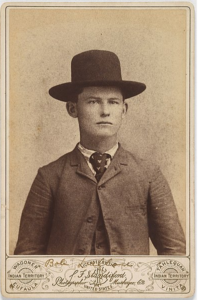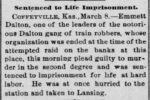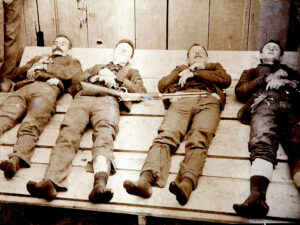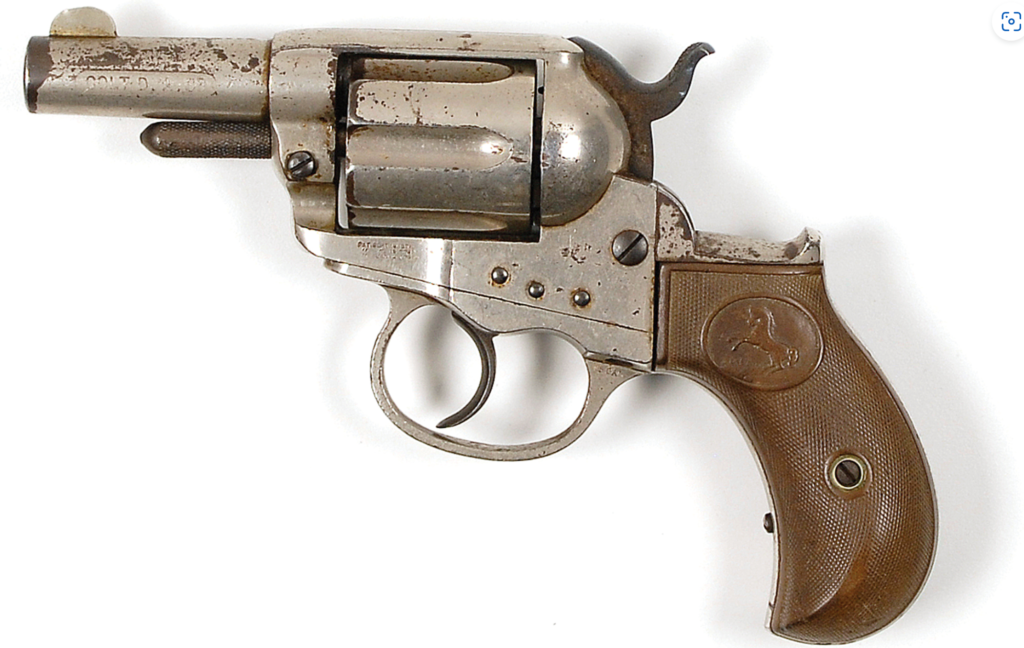Outlaws of the Old West … The Dalton Gang.
May 26, 2023The Dalton Gang: Challenging the Romanticized Narrative of Old West Outlaws.
The Old West is often romanticized for its tales of legendary outlaws who roamed the frontier, their exploits capturing the imagination of many. One such notorious gang was the Dalton Gang, comprising brothers Bob, Emmett, and Grat Dalton, along with their associates. While their story is often depicted through rose-tinted glasses, it is important to peel back the layers and examine their true legacy. Born out of difficult circumstances, the Dalton Gang’s journey into a life of crime was marked by violence, encounters with the law, and a tragic end. This post aims to present a balanced perspective on their lives, shedding light on the less glamorous aspects of their story.
The Dalton brothers were born among 14 children to parents Adaline Younger Dalton and James Lewis Dalton in Jackson County, Missouri, in the late 19th century. Bob Dalton was born on May 13, 1869, Grat Dalton on March 30, 1861, and Emmett Dalton on May 3, 1871. They grew up in a post-Civil War era characterized by lawlessness, poverty, and resentment. The Dalton family’s roots were deeply intertwined with the Confederate cause, which further fueled their discontent. A complete family history is recorded at this link to the Internet Archive’s Wayback Machine. (downloadable PDF is also available.)

Photo of Robert “Bob” Dalton circa 1889
The Dalton brothers initially pursued legitimate careers. Grat worked as a deputy U.S. marshal, and Bob served as a lawman in various roles. However, influenced by their surroundings and perhaps by the perceived glamor of outlawry, they eventually turned to a life of crime. Their transition was gradual, starting with smaller thefts and escalating to train and bank robberies. In 1890, the brothers and their associates held up a train near Adair, Oklahoma, marking the beginning of their criminal endeavors.
The Dalton Gang quickly gained notoriety for their audacious crimes. Known for meticulously planning their robberies, they targeted banks in Kansas, Oklahoma, and other western states. Despite their criminal success, they were not invincible. In 1892, during a failed bank heist in Coffeyville, Kansas, a fierce gunfight erupted between the gang and local townsfolk, resulting in the deaths of Bob, Grat, and two other gang members. Emmett Dalton miraculously survived, although he sustained severe injuries and was later captured.
While the Dalton brothers were not renowned for their words, a few quotes attributed to them offer glimpses into their mindset. Grat Dalton reportedly said, “The world is wrong. It’s never satisfied. Satisfied with itself, it aims to satisfy others, and thereby condemns itself to eternal disappointment.” This quote hints at a deep-seated dissatisfaction that may have influenced their criminal pursuits.
Two banks robbed at the same time?
On October 5, 1892, the famous Dalton Gang attempts the daring daylight robbery of two Coffeyville, Kansas, banks at the same time. But if the gang members believed the sheer audacity of their plan would bring them success, they were sadly mistaken. Instead, they were nearly all killed by quick-acting townspeople.
After riding quietly into town, the men tied their horses to a fence in an alley near the two banks and split up. Two of the Dalton brothers-Bob and Emmett-headed for the First National, while Grat Dalton led Dick Broadwell and Bill Powers in to the Condon Bank. Unfortunately for the Daltons, someone recognized one of the gang members and began quietly spreading the word that the town banks were being robbed. Thus, while Bob and Emmett were stuffing money into a grain sack, the townspeople ran for their guns and quickly surrounded the two banks. When the Dalton brothers walked out of the bank, a hail of bullets forced them back into the building. Regrouping, they tried to flee out the back door of the bank, but the townspeople were waiting for them there as well.
Legends of the Old West podcast has a YouTube audio presentation describing the Coffeyville Raid. “On October 5, 1892, the Dalton Gang attempted one of the most daring robberies in the history of the West. Armed with Winchester rifles, they tried to rob two banks at the same time in broad daylight in Coffeyville, Kansas. The result was a running gun battle with the townsfolk that has become a legend. Special guest discussion with Bob Boze Bell, Executive Editor of True West Magazine.”
 Following the Coffeyville shootout, Emmett Dalton was tried and sentenced to life imprisonment. However, his sentence was eventually commuted, and he was released after serving only 14 years. Remarkably, he later wrote a book, “When the Daltons Rode,” which further contributed to the romanticization of the gang’s story. The film by the same name was a largely fictional film version of the Daltons’ lives adapted from Emmett’s 1931 book. Emmett Dalton’s life after his release from prison was marked by attempts to capitalize on his criminal past through public appearances and lectures. He tried to reclaim his identity but struggled to escape the shadow of his notorious past. He died in 1937, long after the Old West era had faded into history.
Following the Coffeyville shootout, Emmett Dalton was tried and sentenced to life imprisonment. However, his sentence was eventually commuted, and he was released after serving only 14 years. Remarkably, he later wrote a book, “When the Daltons Rode,” which further contributed to the romanticization of the gang’s story. The film by the same name was a largely fictional film version of the Daltons’ lives adapted from Emmett’s 1931 book. Emmett Dalton’s life after his release from prison was marked by attempts to capitalize on his criminal past through public appearances and lectures. He tried to reclaim his identity but struggled to escape the shadow of his notorious past. He died in 1937, long after the Old West era had faded into history.

Condon Bank after the gunfight.
The Dalton Gang’s story is a stark reminder that not all Old West outlaws were swashbuckling heroes fighting for justice. Their journey into a life of crime was shaped by a combination of circumstances, social unrest, and personal choices. While it is natural to be captivated by the tales of the Old West outlaws, it is crucial to approach their narrative with a critical lens, acknowledging the violence and harm they caused.
The Dalton Gang’s birthplace and early life were marred by the aftermath of the Civil War and the hardships that followed. The economic instability, social disarray, and Confederate sympathies within their family environment likely played a role in shaping their perception of the world. However, it is essential to remember that many others faced similar challenges but did not choose a life of crime.
Their route into crime was not a heroic rebellion against an unjust system but rather a series of calculated decisions. The transition from law enforcement to law-breaking reveals a moral compromise driven by personal gain and a desire for notoriety. While they may have been influenced by the romanticized image of outlaws prevalent at the time, their actions cannot be excused or justified. These tragic stories serve as a somber reminder of the violent nature of the outlaws’ lives.

Dalton gang following the 1892 Coffeyville, Kansas raid. Left to right: Bill Powers; Bob Dalton; Grat Dalton, Dick Broadwell.
Wikipedia.
The Dalton Gang’s encounters with the law were a testament to the consequences of their choices. While they successfully carried out several robberies, their luck eventually ran out. The Coffeyville bank raid turned into a deadly confrontation, exposing the gang’s vulnerability. The ensuing gunfight with the townspeople was a tragic event resulting in the deaths of innocent civilians, law enforcement officers, and the Dalton brothers themselves. This incident highlights the real-life consequences of their criminal activities.
The arrests and final days of the Dalton Gang underscore the reality of their choices. Bob and Grat Dalton paid the ultimate price for their crimes, losing their lives during the Coffeyville raid. Emmett Dalton’s survival and subsequent imprisonment served as a reminder of the consequences of their actions. While his release and subsequent attempts to capitalize on his criminal past perpetuated the romanticized narrative, it is crucial to recognize that his later life was marked by struggle and an inability to fully escape the notoriety that plagued him.
In conclusion, the story of the Dalton Gang challenges the romanticized portrayal of Old West outlaws. While their early life and circumstances may have influenced their choices, it is important to acknowledge that their path into crime was driven by personal gain and a willingness to commit violent acts. The Dalton Gang’s exploits were marked by bloodshed, loss of innocent lives, and the erosion of law and order. By examining their lives and criminal activities, we gain a clearer understanding of the harsh realities of the Old West, reminding us that history is not always as glamorous as the legends suggest.

Sold at auction for $36,603. A Colt M1877 ‘Lightning’ double-action revolver that was carried by Lucius M. Baldwin in the Dalton Gang Shootout in Coffeyville, Kansas, which occurred on the morning of October 5, 1892, when the outlaws attempted a daylight robbery of two banks. Baldwin was shot and killed by Bob Dalton as the former turned a corner and ran into the outlaws who, after warning Baldwin to cease his progress, opened fire.
Deadly relic from the 1892 Dalton Gang shootout in Coffeyville.
Disguised with fake beards, the overconfident Dalton Gang formed two teams that fateful day: Grat Dalton, Bill Power, and Dick Broadwell entered the C.M. Condon & Co. Bank, while Bob and Emmett Dalton crossed the plaza to enter the First National Bank. The men were spotted, the authorities alerted, and soon many of Coffeyville’s citizens began to arm themselves from nearby hardware stores. Lucius M. Baldwin was a 23-year-old clerk in the Read Brothers Dry Goods store who picked up this Colt at Isham’s hardware store. Unfortunately for young Baldwin, he exited the back door at Isham’s just as Bob and Emmett Dalton exited the back door of the First National Bank, which was just next door to Isham’s. Both Bob and Emmett aimed their rifles at him and ordered him to halt. When Baldwin continued toward them, Bob shot him through the left chest, a wound that resulted in his passing the next day. Baldwin was one of four Coffeyville citizens killed by the Dalton gang, with three others wounded. At an auction to raise money for the families of the dead townspeople, this revolver was purchased by Hazard W. Read, who passed it down to his daughter Frances Read Kaiser. In 1964, upon her death, it was willed to Charlotte Read Dahlstrom.
This Colt Lightning was on display for many years in the Dalton Museum in Coffeyville, Kansas and, as such, the gun is accompanied by many documents relating to the Dalton Museum (including its original exhibition card) and other probate documents relating to Mrs. Charlotte Dahlstrom’s inheritance and retrieval of the gun from the museum. Also included is a 66-page reprint of an 1892 booklet written by D.S. Elliott, the editor of the Coffeyville Journal, that is titled ‘Last Raid of the Daltons,’ as well as a first edition book entitled What Really Happened on October 5, 1892, by Lue Driver Barndollar, which was printed for the 100th year anniversary of the Dalton Raid and contains pictures of the many known guns that were used in the shootout.